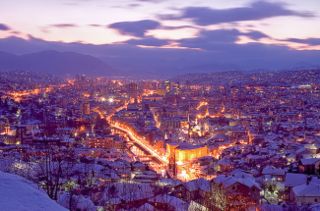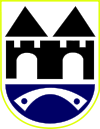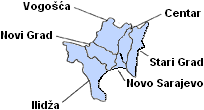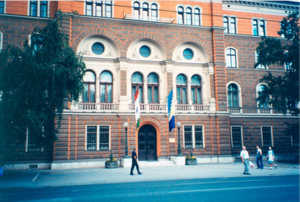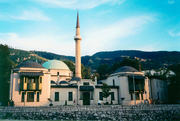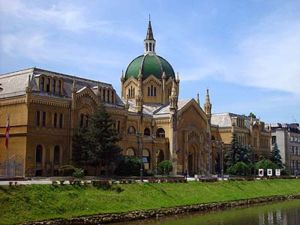Sarajevo
2007 Schools Wikipedia Selection. Related subjects: European Geography
| Sarajevo (Сарајево) | |||||
| Sarajevo in winter | |||||
|
|||||
 |
|||||
| Coordinates: | |||||
|---|---|---|---|---|---|
| Country | Bosnia and Herzegovina | ||||
| Entity | Federation of Bosnia and Herzegovina | ||||
| Canton | Sarajevo Canton | ||||
| Mayor | Semiha Borovac | ||||
| Area | |||||
| - City | 142 km² (54.83 sq mi) | ||||
| Elevation | 500 m (1640.42 ft) | ||||
| Population | |||||
| - City (2005 (est.)) | 308,558 | ||||
| Time zone | Central European Time ( UTC+1) | ||||
| Website: City of Sarajevo | |||||
Sarajevo ( Cyrillic: Сарајево; IPA: [sa'rajɛʋɔ], in English usually [ˌsærəˈjeɪvoʊ]) is the capital city and largest urban centre of Bosnia and Herzegovina, with an estimated population of 308,558 (as of 2005). It is also the capital of the Federation of Bosnia and Herzegovina entity, and the de jure capital of the Republika Srpska entity, as well as the centre of the Sarajevo Canton. Sarajevo is located in the Sarajevo valley of Bosnia proper, surrounded by the Dinaric Alps and situated around the Miljacka river. The city is famous for its traditional religious diversity, with adherents of Islam, Catholicism, Orthodoxy, and Judaism peacefully coexisting there for centuries.
Although settlement in the area stretches back to prehistoric times, the modern city arose as an Ottoman stronghold in the 15th century. Sarajevo has attracted international attention several times throughout its history: In 1914 it was the site of the assassination that sparked World War I, while seventy years later it became the host city of the 1984 Winter Olympics. More recently, Sarajevo underwent the longest siege in modern military history during the Bosnian war. Today the city is recovering and adjusting to a post-war reality, as a major centre of culture and economic development in Bosnia and Herzegovina.
Geography and climate
Sarajevo is located close to the centre of the triangular shape of Bosnia and Herzegovina in southeastern Europe. It consists of four municipalities (or "Općina"): Centar (Centre), Novi Grad (New City), Novo Sarajevo (New Sarajevo), and Stari Grad (Old Town). Greater Sarajevo includes these and the neighbouring municipalities of Ilidža and Vogošća.
The city, located in the Sarajevo valley amongst the Dinaric Alps mountain range, has two rivers flowing through it: the westward flowing Miljacka and the southward flowing Bosna. Covering 142 km² (88.2 mi²) and sitting at 500 meters above sea level, the city is encircled by heavily forested hills and mountains. The city itself has its fair share of hilly terrain, as evidenced by its many steeply inclined streets, not to mention the numerous neighborhoods and settlements that seem to be perched on the hillsides.
Sarajevo has a continental climate, lying between the climate zones of central Europe to the North and the Mediterranean to the South. The year-round average is 10 °C (45 °F) with mild summers (18.1°C or 64.6°F), and cold winters (0.3°C or 32.5°F). The warmest month is July (19°C or 66°F) and the coldest is January (-1°C or 30°F). Sarajevo receives about 932 mm (37 inches) of precipitation a year. The wettest month is October (103 mm or 4.0 in); the driest is March (62 mm or 2.4 in).
History

The Sarajevo valley has a long and rich history dating back to the Neolithic period, when the Butmir Culture flourished. Several Illyrian settlements existed in the area before it was conquered by Rome in 9 CE. During Roman times, a town named Aquae Sulphurae ("sulfuric thermal spring") existed on the location of the present-day Sarajevo suburb of Ilidža. After the Romans, the Goths settled the area, followed by the Slavs in the 7th century.
The settlement Vrh-Bosna existed in the valley as a Slavic citadel from 1263 until it was conquered by the Ottoman Empire in 1429. Under Isa-Beg Isaković, the first Ottoman governor of the Bosnia Province, the settlement was established as a city, named Bosna-Saraj, around the citadel in 1461. The governor oversaw the construction of the city's Old Town district, including a water-supply system, mosque, closed marketplace, public bath, hostel, and Governor's palace. Gazi Husrev-beg was appointed the second governor of the Bosnia Province in 1521 and built the city's first library, madrassa, school of Sufi philosophy, as well as the Sahat Kula clock tower.
In 1697, during the Great Turkish War, a raid was led by Prince Eugene of Savoy of the Habsburg Monarchy against the Ottoman Empire, which conquered Sarajevo and left it plague-infected and burned to the ground. The city was later rebuilt, but never fully recovered from the destruction. The Ottoman Empire made Sarajevo an important administrative centre by 1850, but the ruling powers changed as the Austria-Hungarian Empire conquered Bosnia and Herzegovina in 1878 as part of the Treaty of Berlin, and annexed it completely in 1908. Sarajevo was industrialized by Austria-Hungary, who used the city as a testing area for new inventions, such as tramways, before installing them in Vienna.
In the event that triggered World War I, Archduke Franz Ferdinand of Austria and his wife Sophie, Duchess of Hohenberg, were assassinated in Sarajevo on June 28, 1914 by a Bosnian Serb nationalist named Gavrilo Princep. In the ensuing war, however, most of the Balkan offensives occurred near Belgrade, and Sarajevo largely escaped damage during the war. Following the war, after the Balkans were unified under the Kingdom of Yugoslavia, Sarajevo became the capital of the Drina Province.
In April 1941 Nazi Germany invaded Yugoslavia and bombarded Sarajevo. At this time, there were approximately 10,500 Jews living in Sarajevo, who, along with Romany and Orthodox Serbians, were oppressed by the Ustaše government or transported to concentration camps. Communist Partisan resistance fighters, led by Josip Broz Tito, liberated Sarajevo on 6 April 1945. Afterwards, the city grew rapidly as it became an important regional industrial centre in Yugoslavia. As part of the 1945 General Town Development Plan modern city blocks were built west of the old city, adding to Sarajevo's architectural uniqueness. The peak of city growth occurred in the early 1980s, when Sarajevo hosted the 1984 Winter Olympics.
On April 6, 1992, as former communist state of Yugoslavia was disintegrating, Sarajevo was surrounded by the Yugoslav National Army ( Bosnian: "Jugoslovenska Narodna Armija") and a number of paramilitary ( Bosnian Serb Army) formations. The siege of Sarajevo, which lasted until October 1995, resulted in large scale destruction and dramatic population shifts. Reconstruction of Sarajevo started as soon as the war ended with the Dayton Agreement of November 1995. By 2003, most of the city had been rebuilt, with only a few remaining visible ruins in the city centre. Modern office buildings and skyscrapers have since been constructed throughout the city.
Government
Sarajevo is the capital of the country of Bosnia and Herzegovina and its sub-entity, the Federation of Bosnia and Herzegovina, as well as of the Sarajevo Canton. Each of these levels of government has their parliament or council, as well as judicial courts, in the city. Because of this concentration of power, many foreign embassies are located in Sarajevo.
The city comprises four municipalities which each operate their own municipal government, united to form one city government with its own constitution. The executive branch ( Bosnian: "Gradska Uprava") consists of a mayor, with two deputies and a cabinet. The legislative branch consists of the City Council, or Gradsko Vijeće. The council has 24 members, including a council speaker, two deputies, and a secretary. Councillors are elected by the municipality in numbers roughly proportional to their population. The city government also has a judicial branch based on the post-transitional judicial system as outlined by the High Representative's “High Judicial and Prosecutorial Councils”.
Sarajevo's Municipalities are further split into "local communities" (Bosnian, Mjesne zajednice). Local communities have a small role in city government and are intended as a way for ordinary citizens to get involved in city government. They are based around key neighborhoods in the city.
Demographics
The last official census in Bosnia and Herzegovina took place 1991 which recorded 529,021 people living in Sarajevo. The war displaced hundreds of thousands of people, many of whom have not returned. A 2005 estimate by the Sarajevo Canton government estimated the city's population at 308,558 people, 74% of the Canton's population. With an area of 142 km², Sarajevo has a population density of about 2173 people per square kilometer. The Novo Sarajevo municipality is the most densely populated part of Sarajevo with about 7524 inhabitants per square kilometer, while the least densely populated is the Stari Grad, with 742 inhabitants per square kilometer.
War changed the ethnic and religious profile of the city. While it had long been known as a multicultural city, or Europe's Jerusalem, Muslims Bosniaks returned to form an even greater proportion of people. In 1991 Bosniaks formed 50% of the population, followed by Eastern Orthodox Serbs with 33%, and Roman Catholic Croats with 7%. However, in 1997 Bosniaks formed 87% of the population, with Serbs at 5% and Croats at 6%. If the East Sarajevo ( Republika Srpska) population were to be included (130,000, mostly Serbs), the Bosniaks would still have an absolute majority, followed by Serbs at around 33% of the overall population.
Economy
After decades of communism and years of war, Sarajevo's economy has been subject to reconstruction and rehabilitation programs. Amongst other economic landmarks, the Central Bank of Bosnia and Herzegovina opened in Sarajevo in 1997 and the Sarajevo Stock Exchange began trading in 2002. The city's large manufacturing, administration, and tourism base, combined with a large informal market, makes it one of the strongest economic regions of Bosnia and Herzegovina.
While Sarajevo had a large industrial base during its communist period, only a few pre-existing businesses made the successful transition to the capitalist economy. Sarajevo industries now include tobacco products, furniture, hosiery, automobiles, and communication equipment. Companies based in Sarajevo include B&H Airlines (Formerly Air Bosna), BH Telecom, Bosmal City Centre, Bosnalijek, Energopetrol, Sarajevo Tobacco Factory, and Sarajevska Pivara (Sarajevo Brewery).
Sarajevo has a strong tourist industry and was named by Lonely Planet the 43rd Best City in the World in 2006. Sports-related tourism uses the legacy facilities of the 1984 Winter Olympics, especially the skiing facilities on the nearby mountains of Bjelašnica, Igman, Jahorina, Trebević, and Treskavica. Sarajevo's 600 years of history, influenced by both Western and Eastern empires, is also a strong tourist attraction. Sarajevo has hosted travellers for centuries, because it was an important trading centre during the Ottoman and Austria-Hungarian empires. Examples of popular destinations in Sarajevo include the Vrelo Bosne park, the Sarajevo cathedral, and the Gazi Husrev-beg's Mosque.
Transportation

Sarajevo's location in a valley between mountains make it a compact city. Narrow city streets and a lack of parking areas restrict automobile traffic but allow better pedestrian and cyclist mobility. The two main streets are Titova street and the east-west Zmaj od Bosne (Dragon of Bosnia) highway. The trans-European highway, Corridor 5C, runs through Sarajevo connecting it to Budapest in the north, and Ploce in the south.
Electric tramways, in operation since 1885, are the oldest form of public transportation in the city. There are seven tramway lines supplemented by four trolleybus lines and numerous bus routes. The main railroad station in Sarajevo is located in the north-central area of the city. From there, the tracks head west before branching off in different directions, including to the industrial sector.
Sarajevo International Airport ( IATA: SJJ) is located just a few kilometers southwest of the city. During the war the airport was used for United Nations flights and humanitarian relief. Since the Dayton Accord in 1996, the airport has welcomed a thriving commercial flight business which includes B&H Airlines, Austrian Airlines, Alitalia, Aero Flight, Lufthansa, Jat Airways, Croatia Airlines, and others. In 2004, 397,000 passengers had traveled through Sarajevo airport, whereas only 25,000 had just 8 years earlier in 1996.
Culture
Sarajevo has been home to many different ethnicities and religions for centuries, giving the city a range of diverse cultures. Bosnian Muslims, Orthodox Serbs, Catholic Croats, Jews, and Slovenians all shared the city while maintaining distinctive identities. Today, however, the city is overwhelmingly Bosnian Muslim.
The city is rich in museums, including the Museum of Sarajevo, the Ars Aevi Museum of Contemporary Art, the National Museum of Bosnia and Herzegovina (established in 1888 and home to the Sarajevo Haggadah), the Historical Museum of Bosnia and Herzegovina, and the Museum of Literature and Theatre Arts of Bosnia and Herzegovina. The city also hosts the National theatre of Bosnia and Herzegovina, established in 1919, as well as the Sarajevo Youth Theatre. Other cultural institutions include the Centre for Sarajevo Culture, Sarajevo City Library, Art Gallery of Bosnia and Herzegovina, and the Bosniak Institute, a privately owned library and art collection focusing on Bosniak history.
Demolitions associated with the war, as well as reconstruction, destroyed several institutions and cultural or religious symbols including the Gazi Husrev-beg library, the national library, the Sarajevo Oriental Institute, and a museum dedicated to the 1984 Olympic games. Consequently, the different levels of government estblished strong cultural protection laws and institutions. Bodies charged with cultural preservation in Sarajevo include the Institute for the Protection of the Cultural, Historical and Natural Heritage of Bosnia and Herzegovina (and their Sarajevo Canton counterpart), and the Bosnia and Herzegovina Commission to Preserve National Monuments.
Historically, Sarajevo was home to several famous Bosnian poets and thinkers during the Ottoman Empire. Nobel Prize winner Vladimir Prelog is from the city, as was academy award winning director Danis Tanovic. Nobel Prize winner Ivo Andric spent much of his life in Sarajevo.
The Sarajevo Film Festival, established in 1995, has become the premier film festival in the Balkans. The Sarajevo Winter Festival, Sarajevo Jazz Festival are well-known, as are the Bašćaršija Nights, a month-long showcase of local culture, music, and dance.
The Sarajevo school of pop rock developed in the city between 1961 and 1991. This type of music began with bands like Indexi, Bijelo dugme and singer/song writer Kemal Monteno. It continued into the 1980s, with bands such as Plavi orkestar, Zabranjeno pušenje and Crvena jabuka, ending with the war in 1992.
Sports
Sarajevo was the location of the 1984 Winter Olympics. Yugoslavia won one medal, a silver in men's giant slalom awarded to Slovene Jure Franko. Many of the Olympic facilities survived the war, including Olympic Hall Zetra and Asim Ferhatović Stadion. After co-hosting the Southeast Europe Friendship games, Sarajevo was awarded the 2009 Special Olympic winter games, but cancelled these plans.
Football (soccer) is popular in Sarajevo; the city hosts FK Sarajevo and FK Željezničar, which both compete in European and international cups and tournaments, as well as FK Olimpik. Another popular sport is basketball; the basketball club KK Bosna Sarajevo won the European championship in 1979. The chess club, Bosna Sarajevo, has been a championship team since the 1980s.
Sarajevo often holds international events and competitions in sports such as tennis and kickboxing. Rock climbing is popular; not far from the CBD is the climbing centre Dariva, managed by extreme climbing club Red Point.
| Logo | Club | Leagues | Venue | Established |
|---|---|---|---|---|
 |
FK Željezničar | Premier League of Bosnia and Herzegovina Football Association of Bosnia and Herzegovina |
Grbavica Stadium | 1921 |
 |
FK Sarajevo | Premier League of Bosnia and Herzegovina Football Association of Bosnia and Herzegovina |
Asim Ferhatović Hase Stadium | 1946 |
 |
FK Olimpik Sarajevo | Football Association of Bosnia and Herzegovina First League of the Federation of Bosnia and Herzegovina |
Otoka Stadium | 1993 |
 |
KK Bosna | Premier League of Basketball of Bosnia and Herzegovina Adriatic Basketball Association |
Mirza Delibasic Arena | 1951 |
Education
Higher education has a long tradition in Sarajevo. The first university in Sarajevo was a school of Sufi philosophy established by Gazi Husrev-beg in 1531; numerous other religious schools have been established over time. In 1887, under the Austro-Hungarian Empire, a Sharia Law School began a five-year program. In the 1940s the University of Sarajevo became the city's first secular higher education institute. In the 1950s postgraduate studies first became available. While the university was severely damaged during the war, reconstruction was done in partnership with more than 40 universities. As of 2005, Sarajevo has 46 elementary schools (Grades 1–9) and 33 high schools (Grades 10–13), including three special needs schools.
